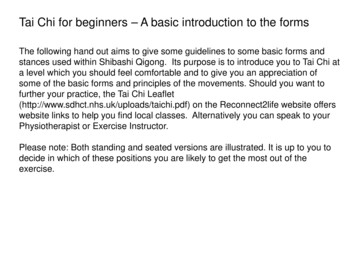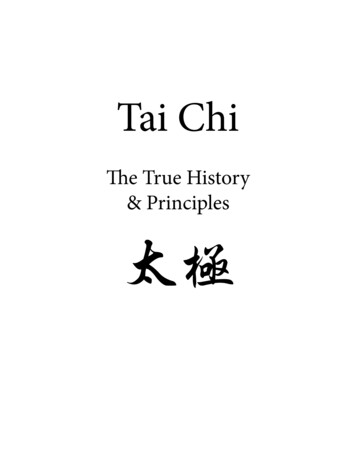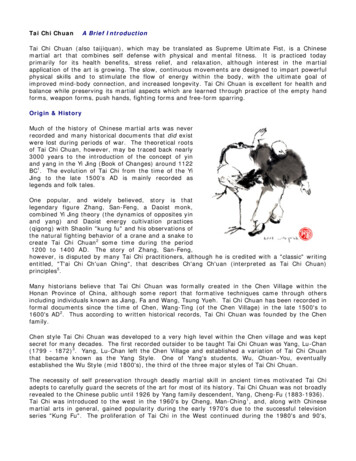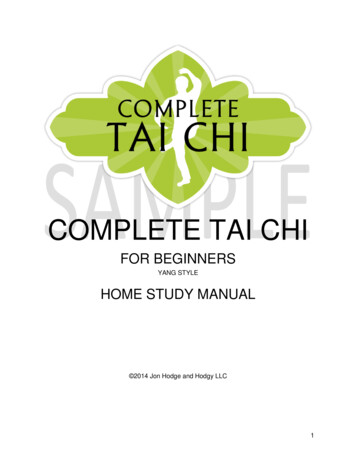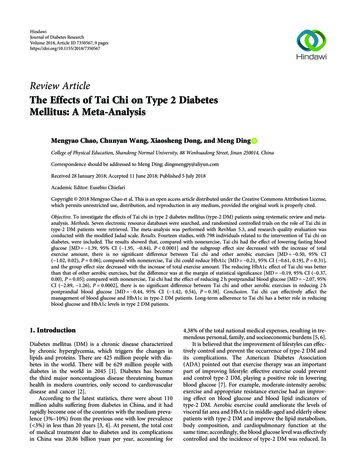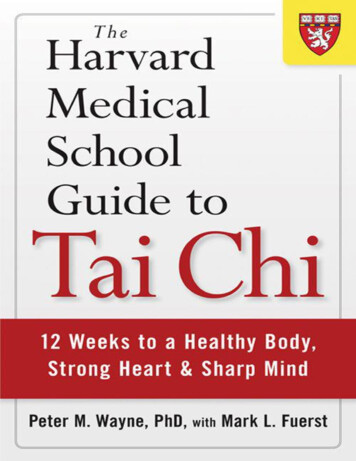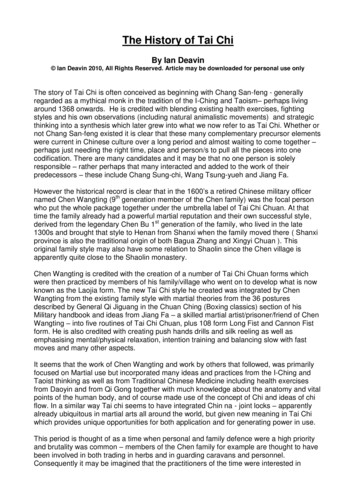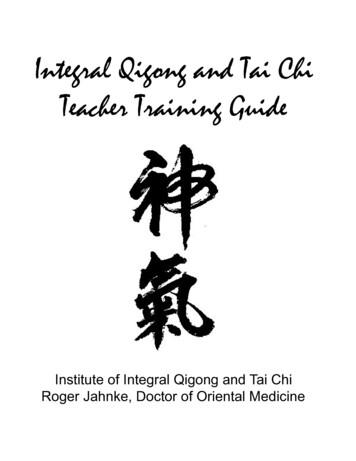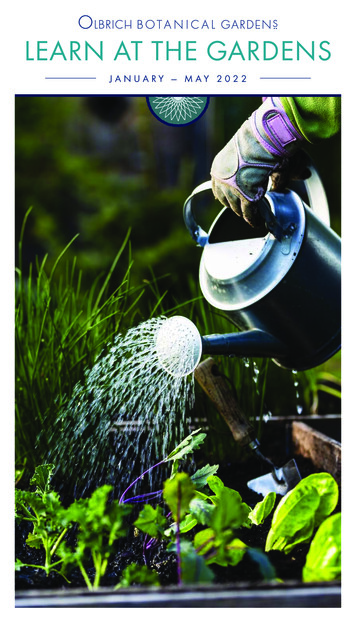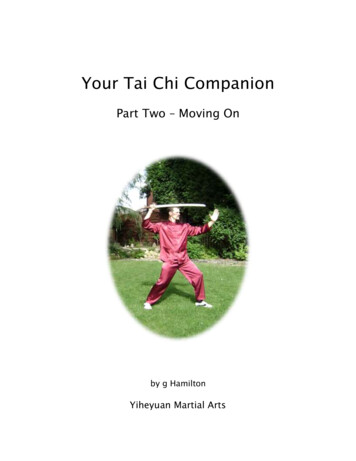
Transcription
Your Tai Chi CompanionPart Two – Moving Onby g HamiltonYiheyuan Martial Arts
ContentsPageWho is this guide for?3What’s in this guide?4A word about styles4A word about Tai Chi as a fighting art5The Tai Chi Principles6Where are you now?7Before you start71. How to Stand Up8Shoulder check92. How to sit down without bending your knees!Verticality check10113. How to walk forwards12Forward stance check134. How to avoid chicken leg145. How to hold your head high (and avoid turning turtle)14Drop your tailbone14Keep your back knee flexed15Suspend the crown-point156. How to Breathe167. How to hold a ball168. How to lift an arm179. How to move backwards and forwards1710. How to move sideways1911. How to uproot a wall19 g Hamilton Yiheyuan Martial Arts 2012All rights reservedPage 1
12. How to grow “roots”2013. How to take an “empty stance”2114. How to “feel your chi”21How are you doing so far?23Tai Chi Troubleshooting24Twelve common Tai Chi errors (and how to avoid them)Going Exploring2527What shape is your form?27So how do we remember forms?28All fingers and thumbs29You can do it with your eyes closed30Remember the square and the circle31Even the mosquito finds no place to land32Speed is of the essence34Why is Tai Chi so slow? Part 1 – It isn’t!35Why is Tai chi so slow? Part 2 – Internal power36Why is Tai chi so slow? Part 3 – Mindfulness37Why is Tai Chi so fast? – Because it’s so slow38Studying the classics40So it’s a martial art then?42Where can you go from here?43References44 g Hamilton Yiheyuan Martial Arts 2012All rights reservedPage 2
Who is this guide for?This guide is for you if: You have been doing Tai Chi for a while (anything from a few weeks to a few years) andyou want to explore the art more deeply. You have been feeling a bit “stuck” or wondering where you are going with your TaiChi. You just want to check that you’re doing it “properly”. You’d like to enjoy more of the health benefits that Tai Chi practice offers. You have been feeling that what you have seen so far is just the tip of an iceberg andyou’re ready to dive in and glimpse some of the secrets of the ancient masters! You intend to take your Tai Chi skills to a high level and want to make sure that allyour foundations are secure first. Or maybe you just want to be able to understand what the more experienced studentsare talking about!Your Tai Chi Companion can help you to: Improve your Tai Chi skills. Deepen your understanding of Tai Chi. Enjoy more benefits from your Tai Chi practice. Prepare for even deeper levels of study.Exploring Tai Chi is one of the most rewarding pastimes there is but from the outside it canseem to be an impenetrable mystery and many give up before they even scratch its surface.Your Tai Chi Companion is designed to be like a best friend who will be right beside you oneach stage of your Tai Chi journey, answering your questions and explaining things as you goalong, so that you can enjoy this process of discovery every step of the way and turn amystery into mastery. g Hamilton Yiheyuan Martial Arts 2012All rights reservedPage 3
What’s in this guide?This booklet is in three sections. The first section will give you an opportunity to look very carefully at your Tai Chi tosee exactly where you are with it. Using the Tai Chi Principles as a guide, you candecide for yourself whether or not you have developed any unusual habits that mightneed a bit of tweaking to make your Tai Chi practice more comfortable, safe andenjoyable. The second section lists twelve common Tai Chi errors and how you can avoid them. The final section offers some exercises, tips, suggestions and insights that could helpyou to enrich your experience of Tai Chi.This is an Intermediate-level guide which is mainly concerned with how you stand and move(your Tai Chi forms) as a basis for more advanced studies later on.A word about stylesIn this guide I will focus on general principles, as laid down in the Tai Chi Classics1. Allauthentic Tai Chi is based on these principles, whatever style you practice. Authentic stylesinclude: Chen Style, Yang Style, Cheng Man Ching Style, Wu Style, Sun Style and Hao Style andthe more modern Beijing forms such as 24 step simplified, 48 step and 42 step, whichcombine elements of the other traditional styles.Having a look at other styles can help you to decide which one is right for you. For example,some people may find the very low stances of Chen Style or the inclined position of Wu Stylequite challenging compared to, for example the Cheng Man Ching, Sun or Yang styles or theSimplified Beijing 24 step form. Depending on the availability of teachers, you may not havemuch choice in this matter but do check out the various styles on YouTube so that at leastyou are aware of what other people are doing. g Hamilton Yiheyuan Martial Arts 2012All rights reservedPage 4
A word about Tai Chi as a fighting artTai Chi is a martial art – one of the oldest and most effective in the world – but you can alsopractice it just as a form of gentle exercise if you choose to. This guide will be helpful to you,whether or not you want to explore the martial aspects.If self-protection is your main reason for taking up Tai Chi , or if you want tostudy and practice the full martial art in a balanced way, that’s great; but for now we’ll mainlyfocus on posture and movement, which will provide a solid foundation for the development ofyour fighting skills later on. Some of the martial reasons for the structural “rules” that followwill be mentioned as we go along and you’ll find a summary of the main martial principles ofTai Chi at the end of this guide.If you would prefer not to think about the fighting side of Tai Chi, that’s OK too- they won’t be mentioned very much in this guide.Of course, if you do find the martial arts side of it even slightly interesting, you are likely toget even more benefits from understanding what each movement was designed for, whichcould help you to do them more accurately and so get the maximum health benefits fromthem.You would also be well advised to explore these aspects if you think you might eventually liketo take your Tai Chi to an advanced level and perhaps even teach it to other people. Even ifyour intention is only to teach Tai Chi for health and relaxation, it is useful to be wellinformed about the art form you are using and where the movements came from. g Hamilton Yiheyuan Martial Arts 2012All rights reservedPage 5
The Tai Chi PrinciplesThe main principles of Tai Chi, as described in the Tai Chi Classics1, are those to do with howto stand and how to move. All Tai Chi practitioners, of all authentic styles, try to follow theseprinciples, whether they are doing it for their health and well-being or for self-protection aswell. These are the “rules” which make Tai Chi what it is and allow you to gain so manybenefits from it. Here’s a summary:1. Your feet should be planted firmly on the ground as if you have roots growingdeeply into the earth.2. Your knees should be unlocked and your weight sunk down into your legs asif you are settling into a comfortable chair.3. Your head should be held upright, as if suspended by an invisible piece ofstring from the crown-point, so that your gaze is level.4. Your spine should be straight and upright with your tailbone dropped towardsthe floor. This will probably happen naturally if you do all of 1-3 above, andyou will also find that 5. Your body can then feel relaxed and supple and 6. Your shoulders and elbows can drop and relax.7. Each part of your body can then feel connected to every other part, “like astring of pearls” so that every movement comes from your whole body ratherthan just one limb.8. When you take a step: let your waist lead, place your foot where it needs togo, then transfer your weight.9. Direct the flow of movement through your legs, waist, arms, hands andfingers, like a whip.10. With practice, your movements will then become balanced, smooth, coordinated, efficient and precise.11. Eventually, your movements will become continuous and flowing, like a river,without interruptions or hesitation, so that someone watching you would notbe able to see where one movement ends and the next one begins. g Hamilton Yiheyuan Martial Arts 2012All rights reservedPage 6
Where are you now?With these principles in mind, you can now begin to take an honest look at what you aredoing when you practice your Tai Chi form. You can check: Your posture – the general way you stand and “carry yourself”. Your stances – the various positions your body moves into and out of as you gothrough your sequence or “form”. How you move from one position to another – checking as you go that you aremoving in a way that is safe for your back and your joints and allows you to feelbalanced and comfortable at all times.Then if necessary, you might like to make a few adjustments and explore some of thebenefits you can gain by doing so.Before you startAlthough not essential, you might like to do one or two of the following to help you in thisprocess. Make a note of any feedback your teacher has given you about your Tai Chi. (Anythinghe or she goes on and on about regularly is likely to be something you could do withexamining a bit more closely.) If you have a full-length mirror handy, that could be useful. If you can get a bit of video footage of yourself doing Tai Chi, that would also be veryhelpful – not to show to anyone; just for your own personal use. You can always deleteit afterwards - unless of course you’re so happy with it you want to put it on YouTube! If you don’t have access to a video camera, a few still pictures of your main posturescould help a lot. What we feel that we are doing, from the inside, isn’t always what weare actually doing, as seen from the outside, so it’s a good idea to check that these twomatch up. g Hamilton Yiheyuan Martial Arts 2012All rights reservedPage 7
Remember Go easy on yourself! You will need to be very honest with yourselfwithout being overly critical; after all, the main reason for any of usdoing Tai Chi is because we enjoy it. Tai Chi is not a “performance art”;it’s a process of self-discovery and self-expression. Potentially it’s adeeply enriching and satisfying experience, so always look at your effortskindly, perhaps with a sense of curiosity, and be ready to enjoy anydiscoveries you might make. You’re the expert on you! We are all unique individuals and you knowyour own body better than anyone else; so if your knees just don’t dothe kind of things that everyone else’s knees seem to take in their stride,that’s OK - just explore what does work for your particular knees!So, if you’re ready, let’s look at some of the things we thought we had pretty much sortedwhen we were about two years old - but Tai Chi does them differently!1. How to stand upA Tai Chi sequence begins and ends with simply standing upright in a relaxed position, eitherwith the heels together and the toes pointing out a bit (between “five to one” and “ten to two”)or with the feet together, toes pointing forwards. In most styles we then step out (usually tothe left but in some forms to the right) into a shoulder-width position.Notice that the feet are level and the toes are pointing forward.If possible, stand up now, step into a shoulder-width position (horseriding stance) and then look down at your feet.Are they level or is one a bit further forward than the other? g Hamilton Yiheyuan Martial Arts 2012All rights reservedPage 8
Are your feet both pointing forwards or are either or both of them pointing outwards orinwards?You might like to take the time to adjust your feet as necessary. Although the above positionis what you are aiming for, if there is a good reason why you are unable to do this (perhapsbecause you are unable to stand up or because your arthritis or old ankle/knee/hip injuryprevents you from lining up your feet like this) don’t worry, just do the nearest you canmanage. You can still enjoy Tai Chi.To be exact, it’s actually the inside edges of your feet that are parallel in this stance. Feet areroughly triangular, so if you line up the outside edges of your feet with parallel floorboards,you will find that your toes turn in a bit, making you appear knock-kneed. Experiment and, ifpossible, have a look in a mirror.Shoulder CheckYou might also like to take this opportunity to have a look at what you thinkof as “shoulder-width”.If you have a full-length mirror, see if the distance between the outsideedges of your feet is the same as the distance between the outside edges ofyour shoulders. If you don’t have a mirror, you could use a tape measure.This sounds obvious but you wouldn’t believe how many people wildlyunder-estimate or over-estimate the width of their shoulders!In some styles the stances may be wider, eg Chen style, but learning theshoulder-width measure is still helpful when your teacher talks about “twiceshoulder-width” or “half shoulder- width”. g Hamilton Yiheyuan Martial Arts 2012All rights reservedPage 9
2. How to sit down without bending your knees!“Is that even possible?” You may well ask! It’s certainly a strange thing to say, but when youget what we mean by this one, it can save you from a whole host of problems.To help you to get it, try the following experiments:1. Stand still and upright with your legs locked out straight . Due to theshape of the human spine, you will find that you have a hollow in the middle of yourback so that if you were standing against a wall you could fit a cushion behind thesmall of your back while your shoulders and bottom touched the wall.2. From standing still and upright, bend your knees. You will probably findthat you are now feeling tension around your knee joints and you may even be bendingforwards a little and sticking your bottom out at the back. If you were standing againsta wall, you would probably fall over.3. From standing still and upright, sit down as if you are resting most of theweight of your body on a fairly high stool, keeping your knees soft and your bodyrelaxed, loose and upright. If you were standing against a wall, your back would be flatagainst it and would simply slide straight down it as your weight sagged into your legs.You will have discovered from these experiments that, although your legs don’t stay lockedout straight in either of them, the result is very different. Why is that?It’s quite a subtle concept but deliberately bending your knees puts your attention into theknees and everything tends to tense up in that area, making it quite uncomfortable andaffecting the posture and balance of your whole body.On the other hand, the idea of “sitting down” and relaxing into your legs allows you just to letgo and trust your bone structure and ligaments to support you while the muscles andtendons around your knees remain soft and comfortable. Your whole body feels balancedand stable and at ease. This one subtle point is the key to the whole of Tai Chi! g Hamilton Yiheyuan Martial Arts 2012All rights reservedPage 10
It may seem a bit of a grand statement that just sitting down into your legs instead ofdeliberately bending your knees is “the key to Tai Chi!”, but it’s actually true and itsimportance really can’t be emphasized enough.Why is “sitting down” so important? It’s the reason why Tai Chi is so good for improving balance and preventing falls. Theweight of your body is now centrally distributed, relaxed and closer to the ground,without putting strain on your knees. Your movements naturally then become morecat-like and less like someone walking on stilts. It’s the key to staying on your feet and using the power of your whole body to protectyourself. Because of the way the spine is constructed, your vertebrae can move more freely inthis position so that you can turn your waist and tuck your tailbone under: twoessential Tai Chi skills, as you will see later.Verticality CheckNow might also be a good time to find out if you are leaning in any direction.Your body should be vertical and you may well feel that you are very upright.However, it is odd how our own internal perceptions can sometimes be a bitout when compared with what we are actually doing when viewed from theoutside.If your teacher has been saying that you tend to lean backwards and you areconvinced that you are not, put it to the test and have someone take a photoof you from the side after you have settled into your “horse-riding stance”.If you find that you were leaning forwards or backwards, try it with your backpressed against a wall. It might feel strange at first but your sense of spatialawareness and balance will gradually adjust to the new setting. g Hamilton Yiheyuan Martial Arts 2012All rights reservedPage 11
3. How to walk forwardsMany Tai Chi students are fine when standing still in ahorse-riding stance, as described above, but as soon asthey take a step forwards, they tend to put one foot directlyin front of the other, as if they are walking on a tightrope,which tenses up the whole body and makes them less ableto sink down and more likely to lose their balance.In Tai Chi, we walk forwards with feet at shoulder width, likewalking along train tracks with one foot on each track. Thisis important because it helps us to keep our balance and touse our power more effectively.In a basic shoulder-width forward stance, your front foot pointsforwards and your heels are placed on the diagonally-opposite cornersof a square (or you may prefer to think of walking along parallel tramlines or train tracks). Notice that the back foot is at a comfortable angleso that you don’t strain your knee or ankle joints. You can experimentwith different angles until you find the foot position that’s mostcomfortable for you.Leaving your back foot stuck out at right angles puts a twist on allyour leg joints, so remember to bring the toes around with youwhen you change direction. The normal way to do this is to keepyour heel on the floor and turn your toes in a bit.Some people like to slide the heel backwards instead because theyfind it more comfortable so this is an option if you have difficultyturning on the heel. However, turning on the heel becomes moreimportant if you want to take your skills to a higher level and perhaps learn how to use TaiChi for self-defence. For now, the most important thing is to avoid leaving your back footsticking out and risking damage to your joints. g Hamilton Yiheyuan Martial Arts 2012All rights reservedPage 12
Forward Stance CheckIf you have access to a floor with floorboards, step into a forwardstance with the inside edge of your front foot in line with theboards. The sideways distance between your heels should beroughly three large floorboards or six narrow floorboards in width,the width of your own shoulders.Notice that it is the inside edge of the front foot which is lined upwith the floorboards.When you settle your weight into your front leg a little, your knee isthen in a comfortable position pointing in the same direction asyour toes. (It won’t be completely above your toes because yourlegs are forming a triangle with the floor.)Check out where the white line touches the floor in the picture, whichshows the correct position. (If you were to try to get your knee directlyover your foot you would end up lop-sided and unbalanced.)When you “sit down” and relax into your legs in this position, as if youare in a comfy chair, your tailbone drops and your spine lengthens,relieving pressure on your lower back and allowing your vertebrae tomove more freely. You can then turn your waist more easily and youbecome more stable, comfortable and balanced.This is the main reason why Tai Chi has helped so many older peopleto reduce their risk of falling2 and, if you are interested in the selfprotection aspects of Tai Chi, you can see (and perhaps feel foryourself) that this position makes you less likely to be knocked over ina fight and more able to issue your own power against an opponent. g Hamilton Yiheyuan Martial Arts 2012All rights reservedPage 13
4. How to avoid “Chicken–leg”This somewhat derogatory term is widely used in Tai Chi circles and it refers to a problemwith the stance that is fairly easily avoided in most cases.If you stand on floorboards in a forward stance with the outside edge of your front foot linedup with the floorboards, you will notice that your knee position changes. Because feet areslightly triangular, your big toe will be pointing a little bit inwards and when you shift yourweight into your front leg, your knee will turn in a little, giving it a bent appearance to anyonelooking at you from the front. That’s “chicken leg” and it’s easily avoided by rememberingthat it’s the inside edge of the foot that should be lined up with the floorboards, big toepointing forwards. If you find that your knee turns inwards even when your foot is in thecorrect position, don’t worry – we are all different. However you may find that regular practiceof consciously but gently aligning your front knee in a forwards direction will graduallyincrease the strength of your thigh muscles until the correct position feels more natural.Chicken leg can also occur during a roll-back when you sink into your back leg and turn yourwaist to deflect an opponent. It’s important to keep your front knee soft and facing in thedirection of your toes (ie towards your opponent) and not allow it to twist inwards or to lockout straight.5. How to hold your head high (and avoid turning turtle)If your teacher has told you that you are leaning forwards, looking down or hunching yourshoulders, and suggests that you keep your head up, it's natural just to leave your body as itis and try to lift your chin. Unfortunately, this leaves you with the same stooping posture butwith your chin jutting out like a turtle, so instead:Drop your tailboneJust sit down a bit more, which straightens and lengthens your spine so that you can pushyour crown point up towards the ceiling, relax your shoulders and settle your spine into a g Hamilton Yiheyuan Martial Arts 2012All rights reservedPage 14
vertical alignment, with your chin in a neutral position and your eyes looking straight forwardrather than down. This not only looks better, it’s also better for your back, allows you tomove more freely and helps you to let go of any tension you might have been carrying aroundwith you.You don’t need to force your tailbone to tuck under to the point where you feel as if you’reabout to fall over backwards; just sink into your legs so that the lower part of your backsettles downwards towards the floor.Keep your back knee flexedIf you straighten your back leg and lock out the knee in your forward stances, it tends tomake you lean forward and you won’t be able to “sit down”. Keeping the back knee softallows you to drop the tailbone as described above and sink your weight into your legs.Dropping your tailbone not only corrects your posture by straightening your spine, it alsoallows you to move your waist freely.In Tai Chi, if the waist doesn't move, nothing moves. For more waist flexibility, sink down abit lower. When you sink, imagine sitting on an office chair and then lowering the seatposition. This keeps the knees soft and natural and the posture erect and comfortable, (unlikemaking a conscious effort to bend the knees which, as we have seen, can result in tension,discomfort and poor posture).Suspend the Crown PointTiny variations in the position of your head, such as looking down or lifting your chin acentimetre too high, can have a big effect on the position of the spine. When you lookstraight forward, as if the Crown Point is suspended from above by a piece of string, the spinefinds its natural alignment and allows the vertebrae to move more freely. Just relaxdownwards and feel the freedom to turn your waist and tuck your tailbone under. If your backstill feels a bit stiff, try adjusting the position of your chin slightly and relaxing down again,allowing your tailbone to drop towards the floor. g Hamilton Yiheyuan Martial Arts 2012All rights reservedPage 15
6. How to BreatheIn Tai Chi, we breathe as if the breath is coming all the way down to the lower abdomen; aregion of the body known as the dantien, which is centred on a point inside you, about aninch below your navel.The concept of “reverse breathing” or “Taoist breathing” will be mentioned in section 13 butfor now it’s fine to just breathe normally and easily but, when you remember, imagine the aircoming in through your nose and all the way down to the dantien region. When you breatheout, imagine the air leaving your body through your skin just below your navel.Of course, your lungs only come down as far as your diaphragm, roughly level with yourmidriff or lower ribs, but the diaphragm displaces your internal organs a little so it feels as ifyou’re breathing into your tummy. And obviously the air isn’t really passing though yourskin, it’s going up and out thought your nose or mouth as normal but this visualization willhelp you to relax and move properly and will be very useful to you later on as you furtherdevelop your skills and understanding of Tai Chi.7. How to hold a ballIn Tai Chi sequences. most of the movements are circular and the handsoften assume a “hold the ball” position.Remember to relax your arms and shoulders so that your elbow drops andrests on the imaginary ball, while the other hand supports it fromunderneath. Lifting the elbow puts a corner on the ball and causes stiffnessin the arm, shoulder, neck and back whereas dropping the elbow, as if theweight of your arm is being supported by the invisible ball, allows all thattension to melt away. g Hamilton Yiheyuan Martial Arts 2012All rights reservedPage 16
8. How to lift an arm (“The raising of the wrist”)With or without a pint of ale in your hand: to lift an arm, first lift the wrist. Imagine you’re apuppet with no strings attached to your elbow or shoulder and someone is pulling your wristupwards with the only available piece of string.When you move into a posture such as White Crane Spreads Wings or Fair Ladies at Shuttles,the arm stays floppy and loose and the shoulders stay relaxed so that the wrist and hand risewithout involving the shoulder or elbow. In White Crane the effect is like cracking a whip; inFair Ladies it’s like inflating a balloon and bouncing something off it.If you find yourself wanting to lift your shoulder or elbow first, imagine having a heavy leadcloak draped around your shoulders and upper arms or even get someone to lightly pressdown on your upper arm as you lift your wrist to give you a feel for how it should move. Theimportance of this will become clearer later but it’s a good idea to get into this habit early on.9. How to move forwards and backwardsHaving taken the time to learn how to do a forward stance properly, the next step is to learnhow to shift your weight forwards and backwards while standing in this position.The trick is to imagine a straight line running forwards and backwards halfway between yourfeet and only move along this line without any side to side movement.Just sit down into your stance and imagine someone pushing on your lower back so that youmove forwards an inch or two and then you just push back a little into their imaginary handso that you end up with a little more weight in your back leg than your front leg. You canalso imagine sitting in an office chair with wheels on and rolling it backwards and forwards,using your thigh muscles to power and control the movement. This allows your back toremain straight, upright and relaxed, as if the chair is taking all your weight.This is actually quite an easy thing to do and yet a surprising percentage of Tai Chipractitioners struggle with this one. It’s very common to see people moving diagonally from g Hamilton Yiheyuan Martial Arts 2012All rights reservedPage 17
one foot to the other and “throwing their hip out”, which is bad for their knees and veryunhelpful for anyone wanting to use Tai Chi as a martial art as it leads to instability.Why is this mistake so widespread? There are several reasons:1. If you move forwards or backwards too far, you will naturally end up moving off thecentre line and putting too much weight into your hip. It can also cause you to end upwith your knee going forwards beyond your toes, which is very bad for your joints andyour back. To avoid this, just take a more minimalist approach and aim to move aninch at a time.2. Because, in a forward stance, your feet are placed at the diagonally opposite corners ofan imaginary square, it’s natural to assume that transferring your weight from one footto the other involves shifting your weight diagonally.3. In Tai Chi circles, people talk about one of the principles from the classics calledavoiding “double-weightedness”. This expression can be interpreted in different ways.One meaning is that your weight does not remain stuck in one place, evenly distributedbetween both feet, for more than a fraction of a second. The reason for this is that youneed to be able to move freely from a standing start to escape an incoming attack andthis is easier if you have one leg light and ready to lift off the floor, whereas beingequally rooted in both feet means that you have a “moment of inertia” to overcomefirst. This is sound advice but you are not double-weighted if your weight isconstantly moving forwards or backwards, even if only by an inch in each direction,therefore you don’t need to be moving from side to side as well.Another interpretation of double-weightedness is having twice as much weight in onefoot than you should, in other words going too far forwards or backwards and endingup throwing your hip out, which is what we were trying to avoid in the first place! Sohowever you interpret the phrase, you’ll be avoiding it by just moving forwards andbackwards an inch or two, avoiding side to side movements or extremes.So having told you not to move
The main principles of Tai Chi, as described in the Tai Chi Classics1, are those to do with how to stand and how to move. All Tai Chi practitioners, of all authentic styles, try to follow these principles, whether they are doing it for their health and well-being or for self-protection as well.
